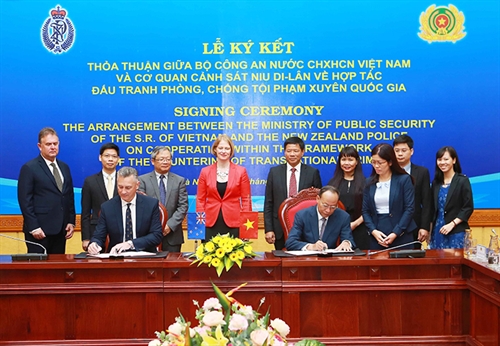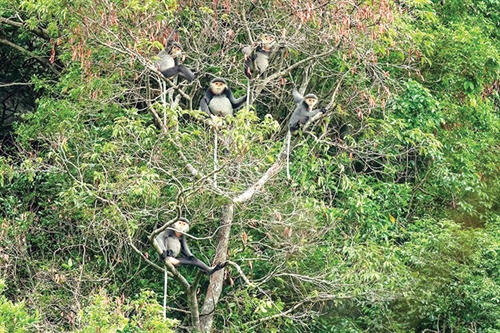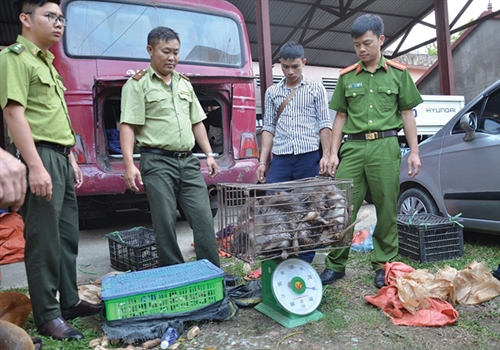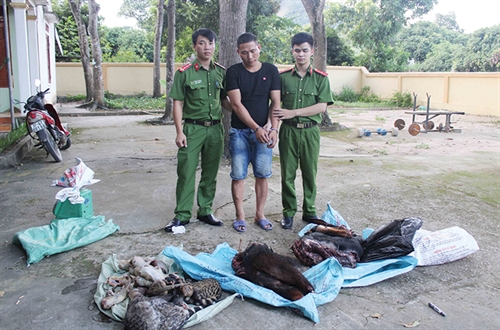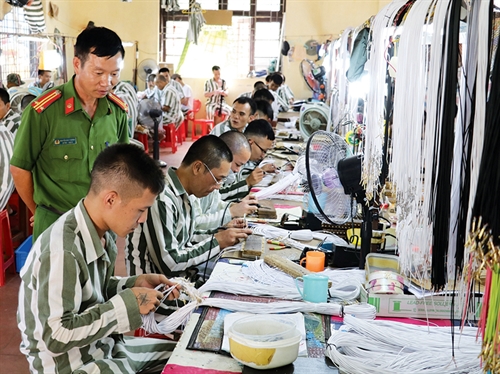Vietnam became an official member of the Convention on International Trade in Endangered Species of Wild Fauna and Flora (CITES) in 1994. Since then, the Convention’s provisions have been step by step incorporated into the country’s legal framework. This article assesses the compatibility between CITES provisions and two important laws concerning wildlife conservation and protection, the 2015 Penal Code and the 2017 Law on Forestry, and puts forth some recommendations for further improvement.
Nguyen Phuong Anh, LL.M
Department of Criminal and Administrative Legislation
Ministry of Justice
CITES provisions on handling of violations of regulations on protection of endangered, precious and rare wild animals
In 1960, CITES[1] was established to ensure that international trade in specimens of wild animals and plants was carried out in a sustainable manner without affecting the survival of species in the wild. Composed of 25 articles and attached appendices, the Convention for the first time provides standardized definitions of “species” and “specimens” and, at the same time, clarifies such activities as “trade”, “re-export” and “introduction from the sea”, and specifies regulations on trade in specimens of species and measures to be taken by the Parties.
CITES has three appendices covering roughly 5,000 fauna species and 29,000 flora species which the Parties commit to protect against overexploitation through international trade. The Parties will base themselves on these appendices, which are considered the standard for identifying animal species threatened with extinction or at risk of extinction due to hunting and trafficking activities of humans, to develop appropriate measures to manage or handle violators, depending on the severity of their violations. For each appendix, there is a specific regulation governing the trade, including import, export, re-export, and introduction from the sea, of species therein.
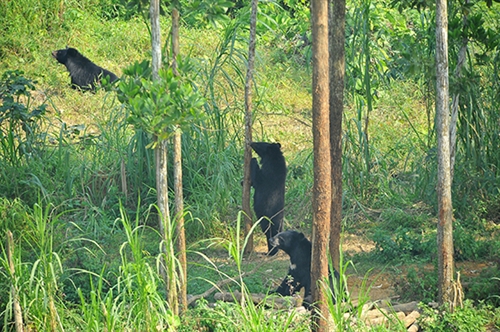 |
| Bears are raised in semi-wild environment at FOUR PAWS Viet’s Bear Sanctuary in Ninh Binh province__Photo: Minh Duc/VNA |
Specifically, Appendix I contains around 1,200 species that are threatened with extinction and are or may be affected by trade. The trade in specimens of these species is subject to particularly strict regulations so that it will not further endanger their survival and may only be authorized in exceptional circumstances. Appendix II includes approximately 21,000 species that are, however, not necessarily now threatened with extinction but may become so unless trade in their specimens is placed under tough regulation in order to avoid utilization incompatible with their survival. Appendix II also deals with other species which are subject to regulation in order to ensure effective control of the trade in specimens of certain species therein. Meanwhile, Appendix III lists about 170 species identified by the Parties themselves as being subject to regulation under their respective jurisdiction for the purpose of preventing or restricting exploitation, and cooperation with other Parties is needed in the control of trade.
In addition, Article 8 of CITES provides measures to be taken by the Parties. Accordingly, the Parties are obliged to take appropriate measures to enforce the provisions of the Convention and to prohibit trade in specimens in violation thereof. These measures include: (i) confiscation or return to the State of export of such specimens; and (ii) internal reimbursement for expenses incurred as a result of the confiscation of a specimen traded in violation of the measures taken in the application of the provisions of CITES.
Revision of Vietnam’s laws on protection of endangered, precious and rare wild animals
The 2015 Penal Code (revised in 2017)
One of the measures to protect wild animals is to examine penal liability of offenders. The 2015 Penal Code (the Code) has three important amendments related to the management and protection of wild animals.
Firstly, the offense of violating regulations on management and protection of wildlife is added with a view to fully implementing recommendations of the Convention (Article 234). This is a new provision introduced for the first time in Vietnam’s Penal Code, which stipulates criminal penalties for the acts of illegally hunting, killing, raising, caging, stockpiling, transporting or trafficking in wild animals or body parts or products of endangered, precious and rare species listed in Appendix II of CITES or of Group IIB as classified under Decree 06 of 2019[2]. Group-II species under Decree 06 of 2019 include forest fauna and flora species that are yet in danger of extinction but may be subject to extinction if not being strictly managed and restricted from exploitation and use for commercial purposes and species defined in Appendix II of CITES which are naturally distributed in Vietnam. Group II is divided into Group IIA - flora species and Group IIB - fauna species[3].
Secondly, the Code revises regulations on management and protection of endangered, precious and rare animals. Article 244 (offense against regulations on protection of endangered, precious and rare animals) lists acts of violating regulations on management and protection of animals on the List of endangered, precious and rare species prioritized for protection; endangered, precious and rare animals of Group IB or in Appendix I of CITES. These acts include: (i) illegally hunting, killing, raising, caging, transporting, or trading in animals on the List of endangered, precious and rare species prioritized for protection; (ii) illegally stockpiling, transporting, or trading in individuals or body parts or products of the animals on the List of endangered, precious and rare species prioritized for protection, elephant tusks or rhino horns; and (iii) committing the offense against animals not included in the List of endangered, precious and rare species prioritized for protection but belong to Group IB animals or are listed in Appendix I of CITES.
Compared to the 1999 Penal Code, the 2015 Penal Code extended the scope of wild animals placed under protection as it not only punishes acts of violating regulations on management and protection of animals on the list of endangered, precious and rare species prioritized for protection, which are those banned from exploitation and use for commercial purpose under Decree 160 of 2013[4],
but also handles violations concerning animals on the list of endangered, precious and rare species of wild plants and animals belonging to Group IB issued under Decree 32 of 2006[5] and listed in Appendix I of CITES.
In addition, Article 244 of the Code defines aggravating circumstances in a clear quantitative manner instead of providing qualitative ones such as “causing serious consequences” or “causing extremely serious consequences”. Article 244 also adds three aggravating circumstances i.e., “abusing the name of an agency or organization”, “cross-border trading or transportation” and “dangerous recidivism”.
The Code also makes important changes to penalties imposed on offenders. Given the profit-driven purpose of environmental offenses in general and offenses of violating regulations on management and protection of endangered, precious and rare wild animals in particular, the scope of application of the fine penalty is expanded while fine levels sharply increase to ensure the deterrence and punishment of violations[6].
Thirdly, both Articles 234 and 244 of the Code provide for criminal liability of commercial legal persons that commit the offenses.
The 2017 Law on Forestry
While the Code prescribes crimes and penalties, the 2017 Law on Forestry[7] (the Law) is a specialized law containing specific provisions on management, protection, development and use of forests; processing and trade of forest products, including also endangered, precious and rare wild animals.
Worthy of note, the Law clearly defines such concepts as “endangered, precious and rare forest plant and animal species” and “specimens”. Accordingly, “endangered, precious and rare forest plant and animal species” are understood as forest plant and animal species of special economic, scientific, medical, ecological, landscape and environmental values which are only a few in the nature or under threat of extinction” (Article 2.14).
Regarding wild animal protection, the Law has the following specific provisions:
- Prohibited acts: Article 9 specifies prohibited acts, e.g., illegally hunting, catching, raising, caging, killing, transporting or trading in forest animals and illegally collecting specimens of forest plant or animal species. These forest plant and animal species obviously include endangered, precious and rare forest plant and animal species.
- Management, protection, exploitation and trade in wildlife: In addition to regulations on the order, procedures and conditions for exploitation of forest products, processing of specimens, commercial management of forest products, trade in specimens, transplantation and reproduction of forest plants, and breeding of forest animals in general and endangered, precious and rare forest plant and animal species in particular, the Law assigns the Government to draw up a list of endangered, precious and rare species of forest plants and animals, formulate mechanisms on management and protection applicable to these species and provide the order and procedures for exploitation of endangered, precious and rare forest plant and animal species as well as wild species of forest plants and animals in the CITES Appendices (Article 38.2).
The Law also specifies conditions for traceability in processing of specimens of forest plants and animals. Accordingly, specimens of endangered, rare, wild species of forest plants and animals and specimens of wild species of forest plants and animals provided in the CITES Appendices may only be permitted for processing if they are (i) legally derived from nurseries or farms; (ii) legally exploited from the nature; or (iii) confiscated under regulations (Article 67.2). Meanwhile, specimens of ordinary forest plant and animal species must be of lawful origin in order to be permitted for processing (Article 67.3).
The Law goes on to underline that the import, export, temporary import, re-export, temporary export, re-export and transit of specimens of forest plant and animal species for commercial purposes must comply with Vietnam’s law and CITES (Article 72.1.d). In addition, the trade in specimens of endangered, precious and rare species of forest plants and animals listed in the CITES Appendices must meet the conditions on traceability and are subject to chain-based management from exploitation, transplantation and raising to processing and consumption (Article 72.2.a).
- Protection and development of special-use forests in order to create a favorable environment for wildlife protection and development: Under Article 46.1 of the Law, particularly for national parks, natural reserves and species-habitat management areas, it is required to maintain the natural structures of forests and ensure natural development of forests in strictly protected zones of special-use forests; restore the structures of natural forests; apply combined natural regeneration and forest enrichment measures, plant native trees in ecological restoration zones of special-use forests; and rescue and conserve species.
- State investment policies: In order to prevent infringements upon forests and forest animals, Article 54 shapes policies on livelihood stabilization for inhabitants living in special-use forests and buffer zones of special-use forests. Besides, Article 94.3 stipulates that the State will invest in protection and rescue of endangered, precious and rare forest animals.
- International cooperation: This is one of the major policies of the State which is provided in Article 4 and Chapter X of the Law with a view to encouraging the expansion of forestry cooperation with countries, territories, and foreign organizations and individuals so as to achieve sustainable development goals and fulfill Vietnam’s commitments on environmental protection and climate change response and other international commitments and, at the same time, boost cooperation with bordering countries in resolving effectively such issues as forest fire, wildfire smoke, illegal trade in timber and specimens of wild plants and animals, and nature conservation.
Assessment of compatibility between Vietnam’s law and CITES provisions
It can be said that Vietnamese lawmakers had formulated the Code and the Law with CITES provisions taken into careful consideration. The incorporation into domestic law of relevant regulations of treaties, including CITES, has gradually harmonized national laws with international laws, and improved effectiveness of international cooperation in crime prevention and control. This not only expresses the Vietnamese Government’s sense of responsibility in implementing international commitments but also shows the country’s efforts in amending and gradually improving its legal framework, thus creating a basis for handling violations of regulations on protection of endangered, precious and rare wild animals, regardless of whether the violators are organizations or commercial legal persons.
However, there remain some issues concerning criminal handling of violations of regulations on protection of endangered, specious and rare wildlife.
Firstly, the Code fails to cover all the objects that need protection as provided by CITES.
Under Article 1.b of CITES, “specimen” is understood as any animal or plant, whether alive or dead; and in case of an animal: for species included in Appendices I and II, any readily recognizable part or derivative thereof; and for species included in Appendix III, any readily recognizable part or derivative thereof specified in Appendix III in relation to the species.
The Law introduces another definition of “specimen”, i.e., forest plants or animals, whether alive or dead, eggs, larvae, parts or derivatives thereof. Meanwhile, Article 244 of the Code only identifies the following specific objects: individual animals (birds, mammals, reptiles, or other animals), parts inseparable from living body and products of animals, elephant ivory and rhino horn. Such a listing on the one hand creates convenience for proceeding-conducting agencies but on the other hand ignores wide range of objects provided by CITES, including animal derivatives (e.g., bear bile, tiger bones, pangolin scales) and eggs and larvae of animals. Furthermore, these derivatives seem not to completely fit with the definition of “parts inseparable from living body” or “animal products” mentioned in the Code[8]. It is not to mention that the definition of “part inseparable from ling body” is quite confusing, thus causing difficulties to law enforcement agencies.
Secondly, regarding the quantitative thresholds and asset valuation serving the identification of criminal acts, the Code sets a specific quantitative level, for example, three individuals, seven individuals, two kilograms, etc. Such provisions might help proceeding-conducting bodies identify elements constituting a criminal offense and appropriate penalties to be imposed on offenders. However, it is not easy to apply these provisions to cases involving animals of different species (birds/mammals/reptiles) or parts of dead animals. In fact, CITES does not provide a specific threshold for determining whether a person who illegally trades in endangered, precious and rare wildlife should be examined for penal liability.
Article 234 of the Code also provides a specific amount of money to quantify the value of endangered wildlife or endangered animals when determining a crime and deciding on a penalty. Such a fixed regulation may obstruct proceeding-conducting agencies in realities because it is not simple to value wildlife, not to mention the disparities between places, regions, and time of capturing, and the fact that many animals are not allowed to be traded in the market, hence, cannot be valued.
Around the world there are extremely endangered species with just a few individuals or even only one individual. So in the case of these species, does the act of illegally trading in one individual animal constitute a crime under the Penal Code? It is not reluctant to mention the purpose of CITES, i.e., to highlight the importance of biodiversity, especially endangered, precious and rare wild fauna and flora species - “an irreplaceable part of the natural systems of the earth which must be protected for this and the generations to come”.[9] This is the reason why the Convention does not provide any specific number.
From the author’s perspective, the Penal Code may provide quantitative levels in aggravating circumstances, but to determine “guilty or not guilty”, it should not provide specific thresholds as at present. Natural persons and legal persons that commit the act of illegally hunting, killing, caging, transporting or trading in endangered, precious and rare wildlife should face criminal charge, regardless of how many individual animals are involved or how much they are worth.
Thirdly, both Article 234.2 and Article 244 of the Code regard “cross-border transportation and trade” as an aggravating circumstance. Maybe, lawmakers want to express Vietnam’s determination to prevent and fight transnational crime, especially wildlife-related cases. However, there are different understandings of “cross-border transportation and trade”. Does it mean that offenders have actually brought animal specimens cross the border into/out of the Vietnamese territory or just intend to do so but are arrested before their intentions are realized? For example, an offender has managed to transport animals in Appendix I of CITES to a border gate but not yet fulfilled import/export procedures, whether the aggravating circumstance of “cross-border transportation or trade” will be applied in this case. Looking back at CITES, we can see that the Convention only stipulates that “trade” covers such activities as import, export, re-export, and introduction from the sea. Thus, it could be understood that activities with the purpose of import, export, or introduction from the sea, including also water areas outside any country’s territory, can be regarded as illegal trade in endangered, precious and rare wildlife.
In the author’s opinion, to avoid different and inconsistent interpretations of legal provisions, related authorities should issue guiding documents to unify the understanding of “cross-border transportation and trade”.
Lastly, the author suggests that the Supreme People’s Court should select and issue court precedents concerning violations of the environmental law in general and regulations on management and protection of endangered, precious and rare wildlife in particular so as to facilitate the application of case laws to handle these violations in a more effectively and timely manner.-
[1] The Convention on International Trade in Endangered Species of Wild Fauna and Flora was opened for signature in Washington DC, the United States, on March 1, 1973, and entered into force on June 1, 1975. Vietnam was the 121st Party joining CITES on January 20, 1994.[2] Government Decree 06/2019/ND-CP of January 22, 2019, on the management of endangered, precious and rare wild fauna and flora, and the implementation of the Convention on International Trade in Endangered Species of Wild Fauna and Flora (effective on March 10, 2019).[3] Article 4.1.b of Decree 06/2019/ND-CP.[4] Government Decree 160/2013/ND-CP of November 12, 2013, on the criteria to determine species and the regime of managing species on the list of endangered, precious and rare species prioritized for protection.[5] Government Decree 32/2006/ND-CP of March 30, 2006, on management of endangered, precious and rare species of wild plants and animals.[6] Drafting Board of the Penal Code (amended), Proclamation and ensuring conditions for detailed exploitation of the Draft Penal Code (amended), Hanoi, 2015, p. 46.[7] Law on Forestry 16/2017/QH14 dated November 15, 2017, effective on August 1, 2018.[8] Reference: Nguyen Van Pha (editor), Protect endangered, precious and rare wild animals by criminal law of Vietnam, Labor Publishing House, Hanoi, 2018, pp. 119-120.[9] Introduction, CITES

